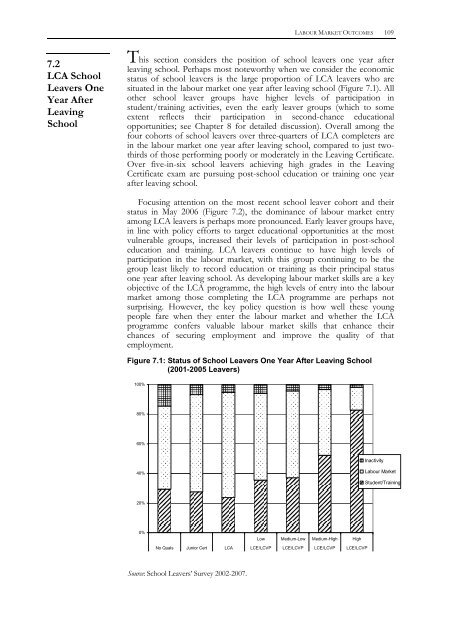Student Experiences of the Leaving Certificate Applied Programme
Student Experiences of the Leaving Certificate Applied Programme
Student Experiences of the Leaving Certificate Applied Programme
You also want an ePaper? Increase the reach of your titles
YUMPU automatically turns print PDFs into web optimized ePapers that Google loves.
LABOUR MARKET OUTCOMES 1097.2LCA SchoolLeavers OneYear After<strong>Leaving</strong>SchoolThis section considers <strong>the</strong> position <strong>of</strong> school leavers one year afterleaving school. Perhaps most noteworthy when we consider <strong>the</strong> economicstatus <strong>of</strong> school leavers is <strong>the</strong> large proportion <strong>of</strong> LCA leavers who aresituated in <strong>the</strong> labour market one year after leaving school (Figure 7.1). Allo<strong>the</strong>r school leaver groups have higher levels <strong>of</strong> participation instudent/training activities, even <strong>the</strong> early leaver groups (which to someextent reflects <strong>the</strong>ir participation in second-chance educationalopportunities; see Chapter 8 for detailed discussion). Overall among <strong>the</strong>four cohorts <strong>of</strong> school leavers over three-quarters <strong>of</strong> LCA completers arein <strong>the</strong> labour market one year after leaving school, compared to just twothirds<strong>of</strong> those performing poorly or moderately in <strong>the</strong> <strong>Leaving</strong> <strong>Certificate</strong>.Over five-in-six school leavers achieving high grades in <strong>the</strong> <strong>Leaving</strong><strong>Certificate</strong> exam are pursuing post-school education or training one yearafter leaving school.Focusing attention on <strong>the</strong> most recent school leaver cohort and <strong>the</strong>irstatus in May 2006 (Figure 7.2), <strong>the</strong> dominance <strong>of</strong> labour market entryamong LCA leavers is perhaps more pronounced. Early leaver groups have,in line with policy efforts to target educational opportunities at <strong>the</strong> mostvulnerable groups, increased <strong>the</strong>ir levels <strong>of</strong> participation in post-schooleducation and training. LCA leavers continue to have high levels <strong>of</strong>participation in <strong>the</strong> labour market, with this group continuing to be <strong>the</strong>group least likely to record education or training as <strong>the</strong>ir principal statusone year after leaving school. As developing labour market skills are a keyobjective <strong>of</strong> <strong>the</strong> LCA programme, <strong>the</strong> high levels <strong>of</strong> entry into <strong>the</strong> labourmarket among those completing <strong>the</strong> LCA programme are perhaps notsurprising. However, <strong>the</strong> key policy question is how well <strong>the</strong>se youngpeople fare when <strong>the</strong>y enter <strong>the</strong> labour market and whe<strong>the</strong>r <strong>the</strong> LCAprogramme confers valuable labour market skills that enhance <strong>the</strong>irchances <strong>of</strong> securing employment and improve <strong>the</strong> quality <strong>of</strong> thatemployment.Figure 7.1: Status <strong>of</strong> School Leavers One Year After <strong>Leaving</strong> School(2001-2005 Leavers)100%80%60%Inactivity40%Labour Market<strong>Student</strong>/Training20%0%Low Medium-Low Medium-High HighNo Quals Junior Cert LCA LCE/LCVP LCE/LCVP LCE/LCVP LCE/LCVPSource: School Leavers’ Survey 2002-2007.

















